Price remains below the short-term invalidation point. Both short-term Elliott wave counts remain valid.
A flag pattern is identified for Gold. A target is calculated using the flag pole.
Summary: Three long-term targets are now calculated for cycle wave c to end. Confidence in a new downwards trend may be had with a new low below 1,160.75.
The mid-term target for a third wave down is at 1,207. A target calculated using the flag is about 1,231.
For the short term, a new low now below 1,298.34 would add some confidence that the downwards trend has resumed.
New updates to this analysis are in bold.
Grand SuperCycle analysis is here.
Last monthly charts are here. Video is here.
MAIN ELLIOTT WAVE COUNT
WEEKLY CHART – TRIANGLE
This is the preferred wave count.
Cycle wave b may be a complete regular contracting triangle. If it continues further, then primary wave E may not move beyond the end of primary wave C above 1,365.68.
Four of the five sub-waves of a triangle must be zigzags, with only one sub-wave allowed to be a multiple zigzag. Wave C is the most common sub-wave to subdivide as a multiple, and this is how primary wave C for this example fits best.
There are no problems in terms of subdivisions or rare structures for this wave count. It has an excellent fit and so far a typical look.
This wave count would expect a cycle degree trend change has recently occurred. Cycle wave c would most likely make new lows below the end of cycle wave a at 1,046.27 to avoid a truncation.
Primary wave E should exhibit reasonable weakness as it comes to an end. Triangles often end with declining ATR, weak momentum and weak volume.
If this weekly wave count is correct, then cycle wave c downwards should develop strength, ATR should show some increase, and MACD should exhibit an increase in downwards momentum.
Three targets are calculated for cycle wave c. Cycle wave a lasted 4.25 years. Cycle wave b may be over in 3.17 years. Cycle wave c may last a minimum of 2 years and possibly up to 5 years.
DAILY CHART – TRIANGLE
Cycle wave c must subdivide as a five wave structure, either an impulse or an ending diagonal. An impulse is much more common and that shall be how it is labelled unless overlapping suggests a diagonal should be considered.
A new trend at cycle degree should begin with a five wave structure on the daily chart, which will be labelled minor wave 1. Minor wave 2 now looks like an obvious three wave structure on the daily chart. It is still possible that minor wave 2 could continue higher as a double zigzag. An alternate hourly chart below outlines this possibility.
Minor wave 2 may not move beyond the start of minor wave 1 above 1,345.90.
HOURLY CHART
Minor wave 2 may now be a complete single zigzag, the most common structure for a second wave. A channel is drawn about minor wave 2 using Elliott’s technique. Minute wave c may have ended about resistance at the upper edge.
The channel is now strongly breached by downwards movement, and that may be taken as indication that minor wave 2 may be over and minor wave 3 downwards may be underway.
A target is calculated for minor wave 3 to reach the most common Fibonacci ratio to minor wave 1.
Minor wave 3 may only subdivide as an impulse, and within it minute wave ii may not move beyond the start of minute wave i above 1,310.95.
Minute wave ii may now be a complete zigzag, with minuette wave (c) just 0.48 short of equality in length with minuette wave (a). Minuette wave (c) subdivides as an ending contracting diagonal.
A new low below 1,298.34 would invalidate the alternate hourly wave count below and provide some confidence in this main hourly wave count.
ALTERNATE HOURLY CHART
If the degree of labelling within minor wave 2 is moved down one degree, the zigzag over at the last high may have only been the first zigzag in a double zigzag.
Double zigzags are fairly common structures for second waves.
Draw a channel about this double zigzag. Draw the first trend line from the start of minor wave 2 to the low labelled minute wave x, then place a parallel copy on the high labelled minute wave w.
A target is calculated at two degrees for the end of minor wave 2. This target expects very strong resistance about 1,310 to be overcome, which may be unlikely.
This wave count sees the downwards day of 14th of March as an X wave. X waves are analogous to B waves: they should exhibit weakness. This was a strong downwards day that had good support from volume. This does not look like a normal X wave.
The downwards wave labelled minute wave x is for this wave count seen as a zigzag. It will subdivide as either a zigzag or an impulse, but it does look better as an impulse. The probability of this wave count is judged to be very low.
Within the second zigzag of the double labelled minute wave y, minuette waves (a) and (b) may now be complete. Minuette wave (c) may have begun with a leading contracting diagonal for subminuette wave i. Subminuette wave ii may not move beyond the start of subminuette wave i below 1,298.34.
WEEKLY CHART – DOUBLE ZIGZAG
It is possible that cycle wave b may be an incomplete double zigzag or a double combination.
The first zigzag in the double is labelled primary wave W. This has a good fit.
The double may be joined by a corrective structure in the opposite direction, a triangle labelled primary wave X. The triangle would be about four fifths complete.
Within multiples, X waves are almost always zigzags and rarely triangles. Within the possible triangle of primary wave X, it is intermediate wave (B) that is a multiple; this is acceptable, but note this is not the most common triangle sub-wave to subdivide as a multiple. These two points reduce the probability of this wave count.
Intermediate wave (D) may be complete. The (B)-(D) trend line is almost perfectly adhered to with the smallest overshoot within intermediate wave (C). This is acceptable.
Intermediate wave (E) should continue to exhibit weakness: ATR should continue to show a steady decline, and MACD may begin to hover about zero.
Intermediate wave (E) may not move beyond the end of intermediate wave (C) below 1,160.75.
This wave count may now expect downwards movement for several weeks.
Primary wave Y would most likely be a zigzag because primary wave X would be shallow; double zigzags normally have relatively shallow X waves.
Primary wave Y may also be a flat correction if cycle wave b is a double combination, but combinations normally have deep X waves. This would be less likely.
This wave count has good proportions and no problems in terms of subdivisions.
ALTERNATE ELLIOTT WAVE COUNT
WEEKLY CHART
If Gold is in a new bull market, then it should begin with a five wave structure upwards on the weekly chart. However, the biggest problem with this wave count is the structure labelled cycle wave I because this wave count must see it as a five wave structure, but it looks more like a three wave structure.
Commodities often exhibit swift strong fifth waves that force the fourth wave corrections coming just prior to be more brief and shallow than their counterpart second waves. It is unusual for a commodity to exhibit a quick second wave and a more time consuming fourth wave, and this is how cycle wave I is labelled. The probability of this wave count is low due to this problem.
Cycle wave II subdivides well as a double combination: zigzag – X – expanded flat.
Cycle wave III may have begun. Within cycle wave III, primary wave 1 may now be complete. The target for primary wave 2 is the 0.618 Fibonacci ratio of primary wave 1. Primary wave 2 may not move beyond the start of primary wave 1 below 1,160.75.
A black channel is drawn about primary wave 1. Primary wave 2 may breach the lower edge of this channel.
Cycle wave III so far for this wave count would have been underway now for 27 weeks. It should be beginning to exhibit some support from volume, increase in upwards momentum and increasing ATR. However, volume continues to decline, ATR continues to decline and is very low, and momentum is weak in comparison to cycle wave I. This wave count lacks support from classic technical analysis.
TECHNICAL ANALYSIS
WEEKLY CHART
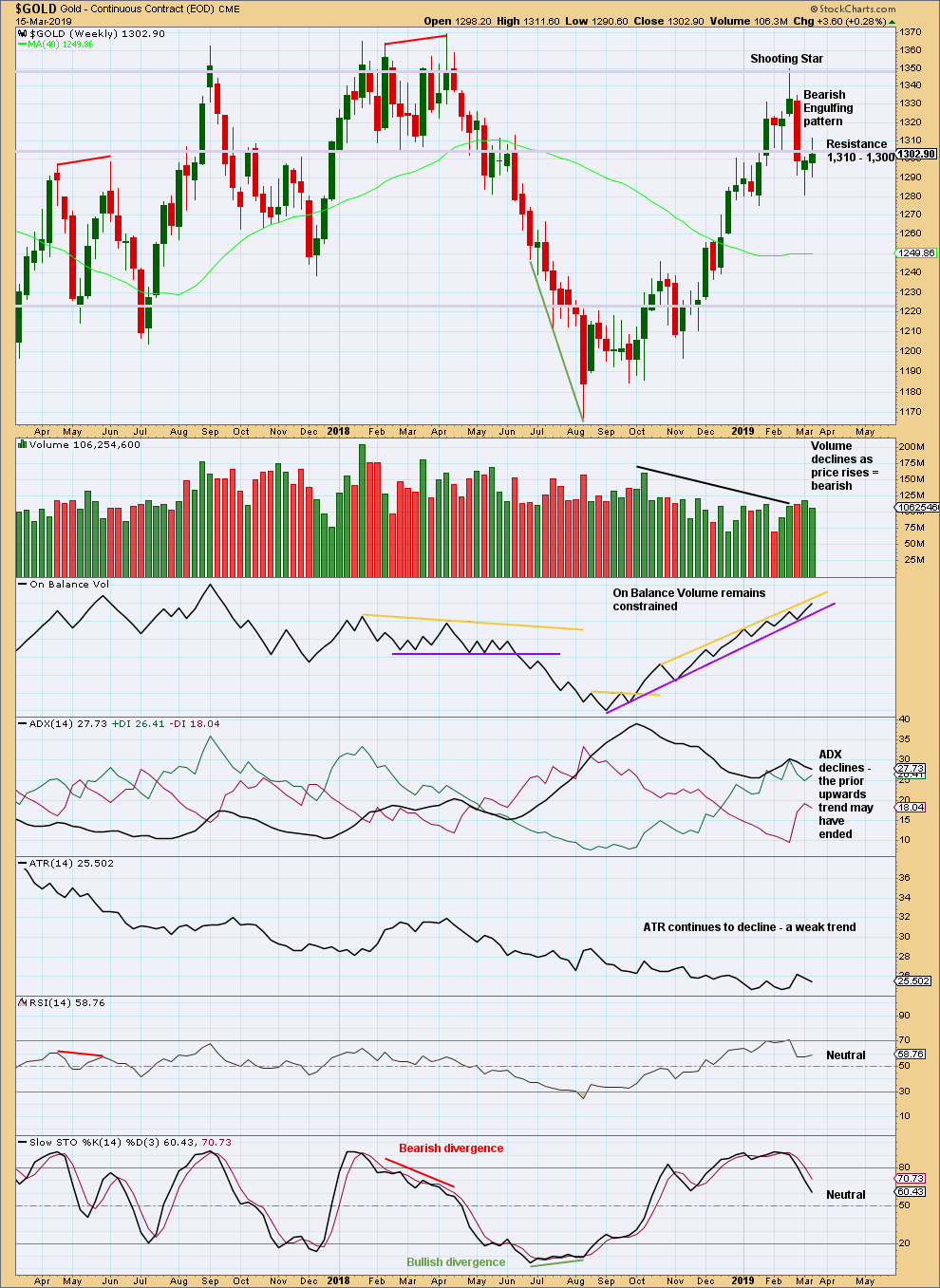
Click chart to enlarge. Chart courtesy of StockCharts.com.
There are now two bearish candlestick reversal patterns on the weekly chart: a Shooting Star and a Bearish Engulfing pattern. This supports the view that a high is in place.
For the short term, price has not managed to close back above strong resistance at 1,310. This upwards bounce looks like a typical back test of resistance, which was prior support.
DAILY CHART
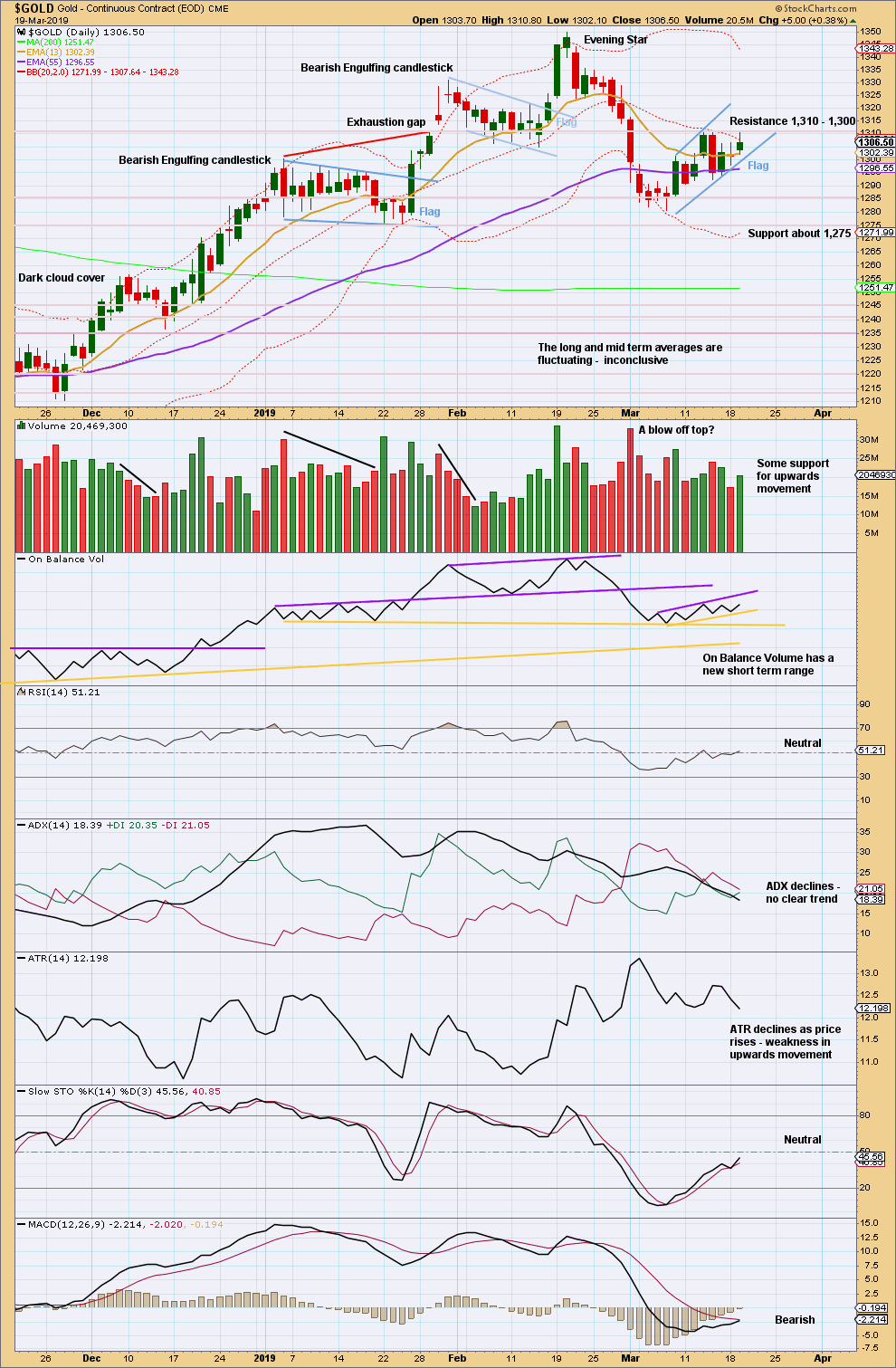
Click chart to enlarge. Chart courtesy of StockCharts.com.
Strong resistance about 1,300 to 1,310 remains intact. Sideways and higher movement of the last eight sessions now looks like a flag pattern.
Flags are one of the most reliable continuation patterns. A target calculated using the flag pole is about 1,231.
A breakout would be indicated by a downwards day that closes below the lower flag trend line. Volume would not be required for confidence.
GDX WEEKLY CHART
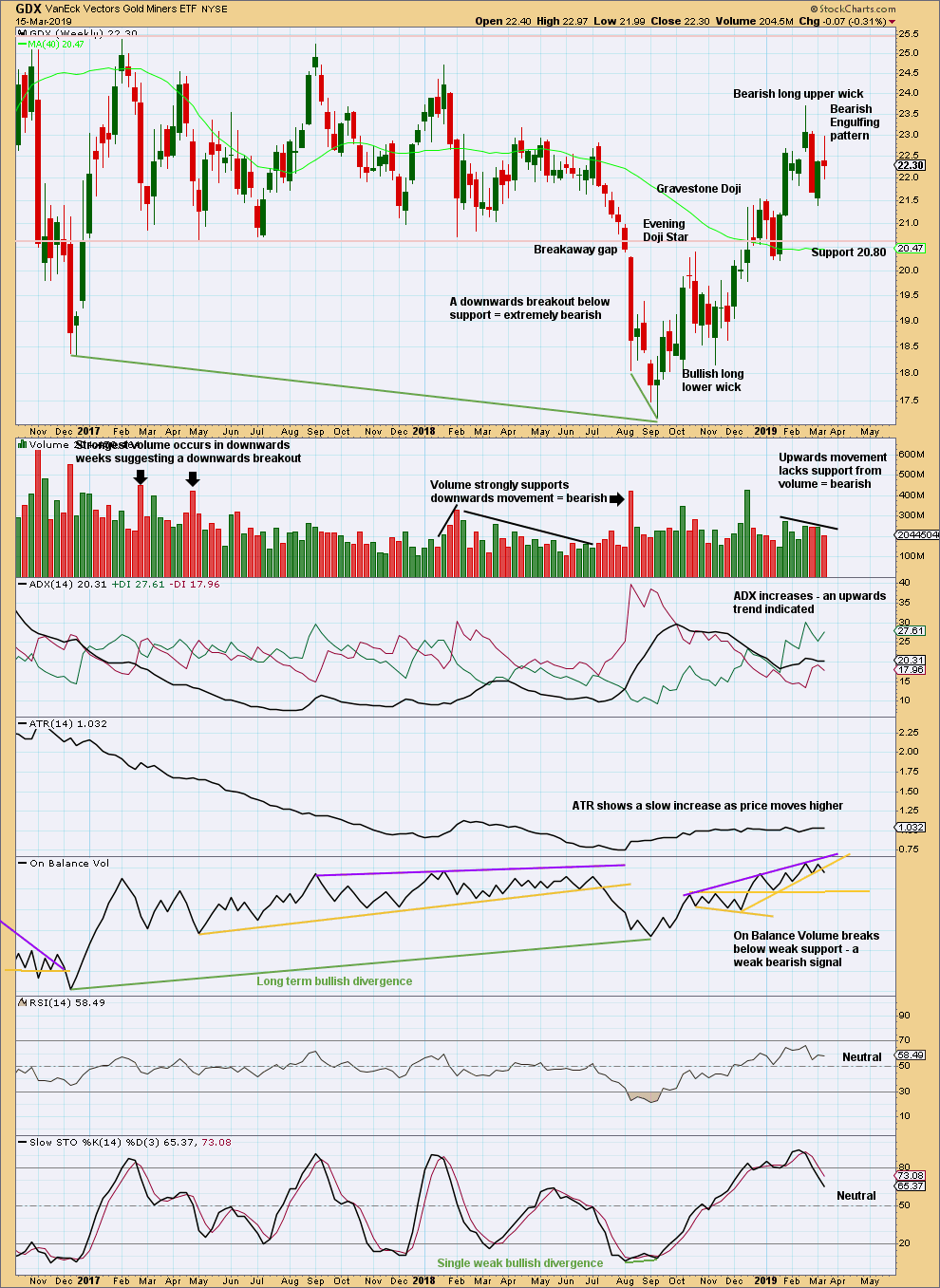
Click chart to enlarge. Chart courtesy of StockCharts.com.
The Bearish Engulfing pattern at the weekly chart level should still be given weight in this analysis. It signals an end to the upwards trend and a new downwards or sideways trend.
Last week completes an upwards week with the balance of volume down. The short-term volume profile should be judged on the daily chart. The mid-term profile is bearish. On Balance Volume is bearish.
Although ADX now indicates an upwards trend, this may be treated with some suspicion. A new swing low below the prior low of the week beginning 22nd January at 20.22 would confirm a trend change.
GDX DAILY CHART
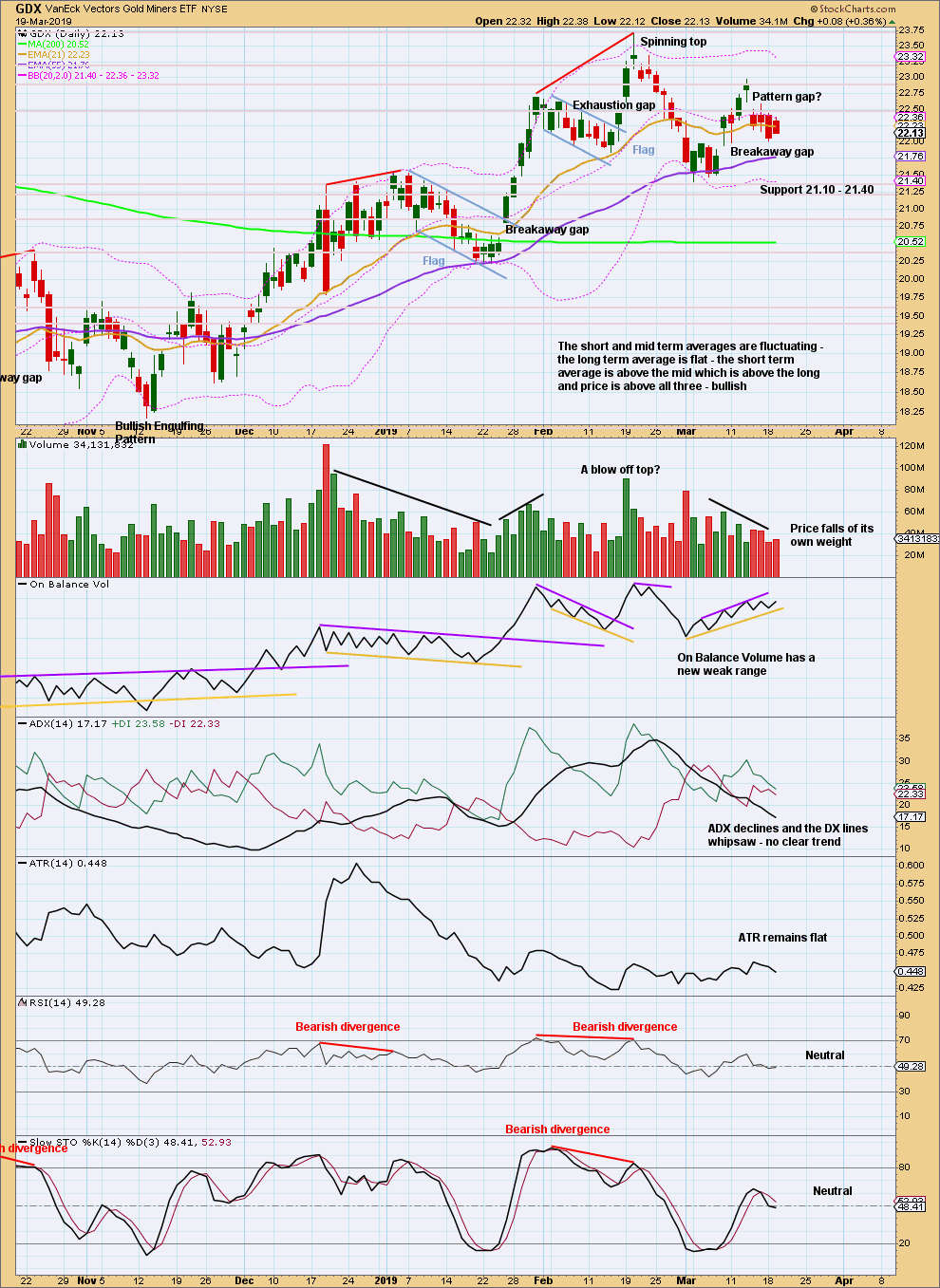
Click chart to enlarge. Chart courtesy of StockCharts.com.
Look for support at the breakaway gap at 21.89 and resistance above about 22.50 and then 22.90.
If the breakaway gap is closed, then it would be relabelled a pattern gap.
Published @ 10:46 p.m. EST.
—
Careful risk management protects your trading account(s).
Follow my two Golden Rules:
1. Always trade with stops.
2. Risk only 1-5% of equity on any one trade.

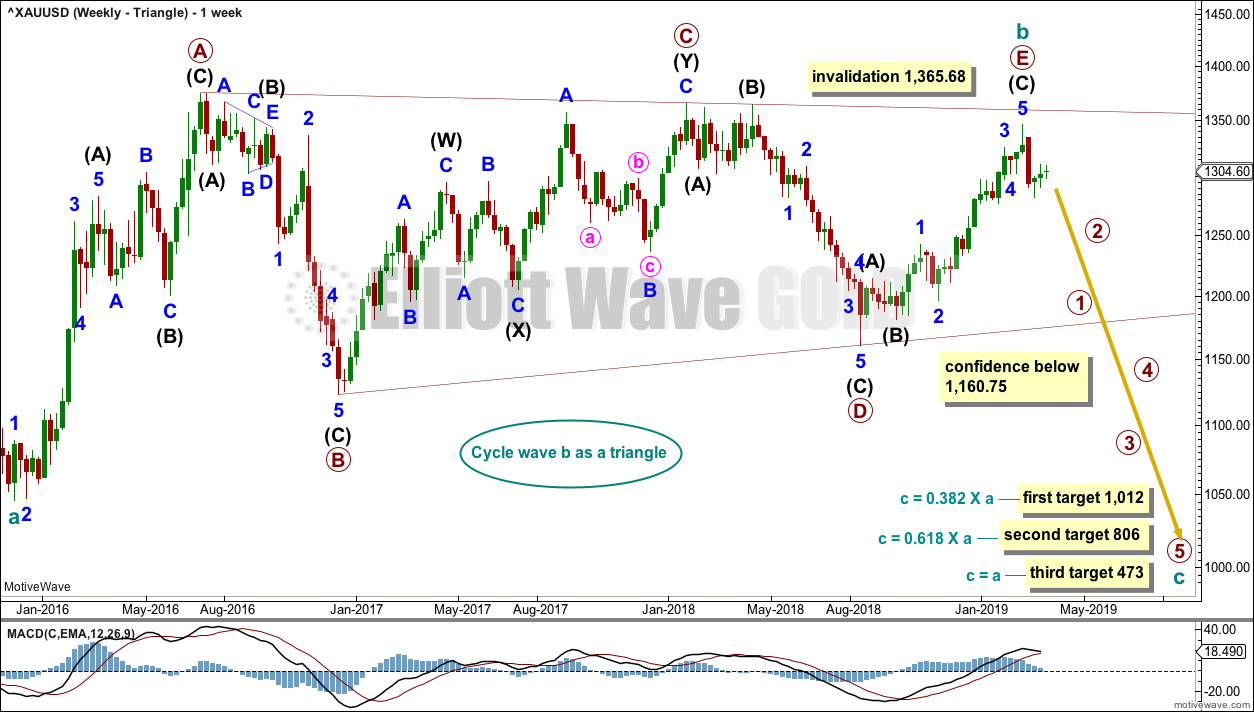

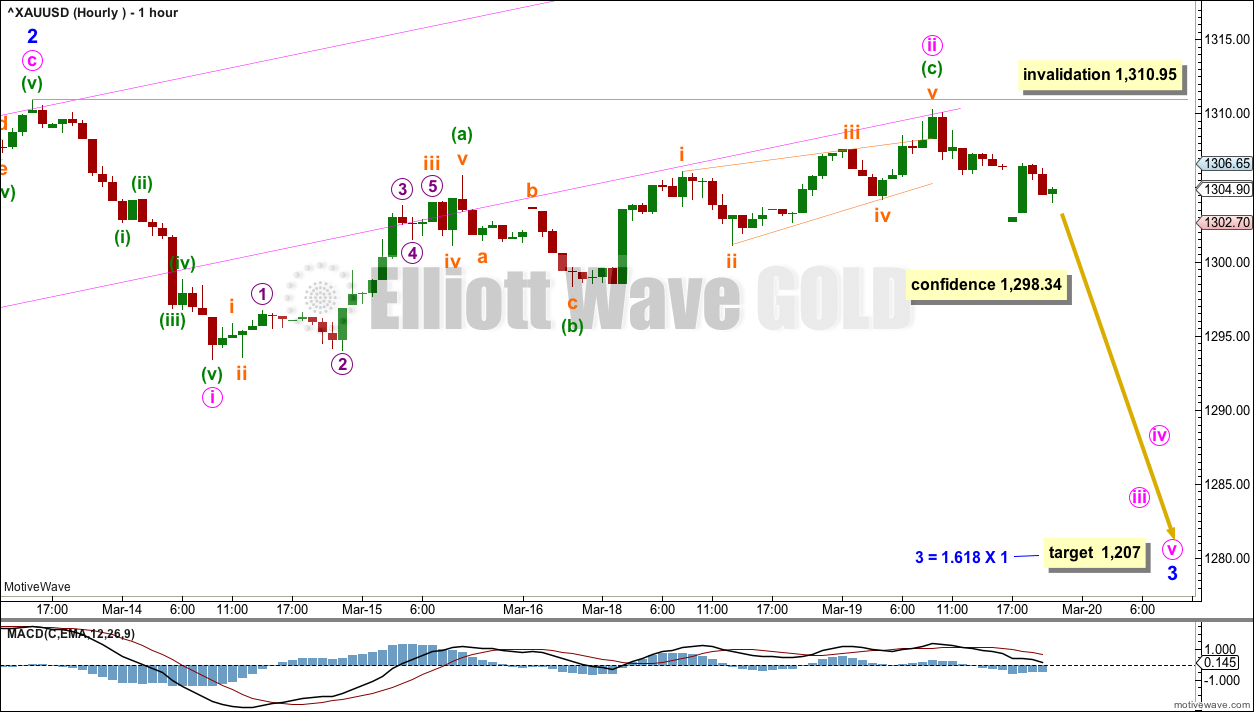
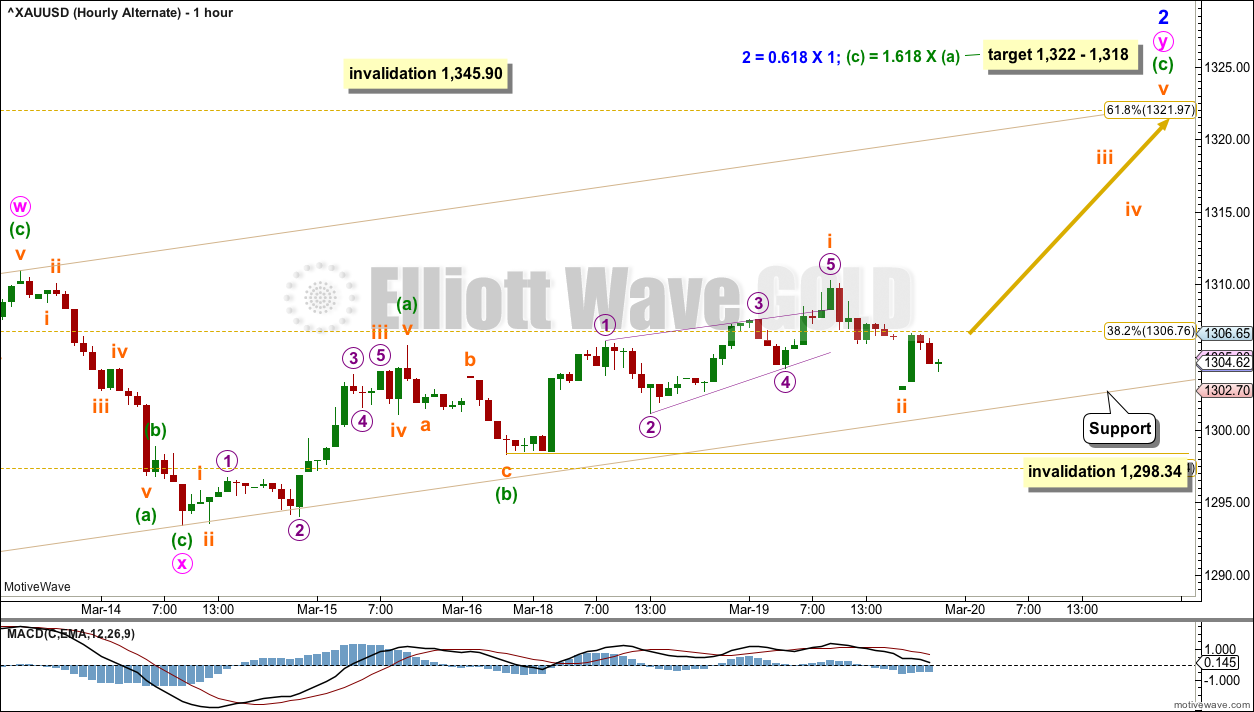
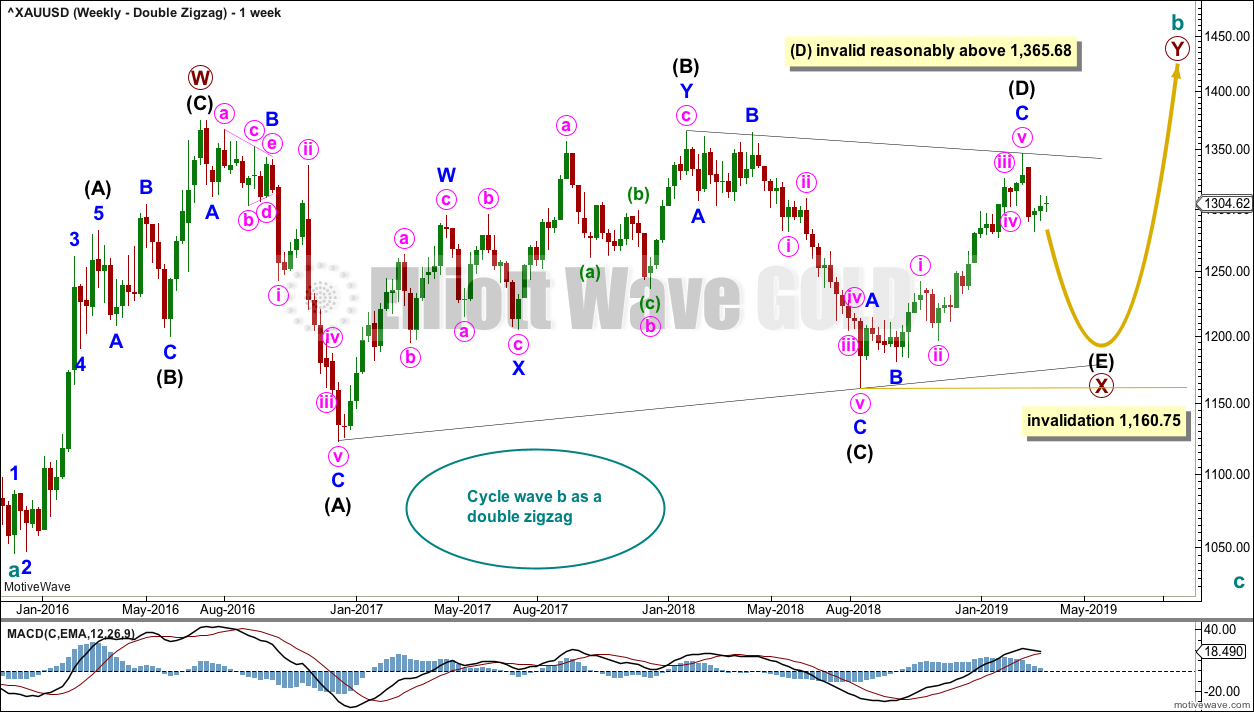
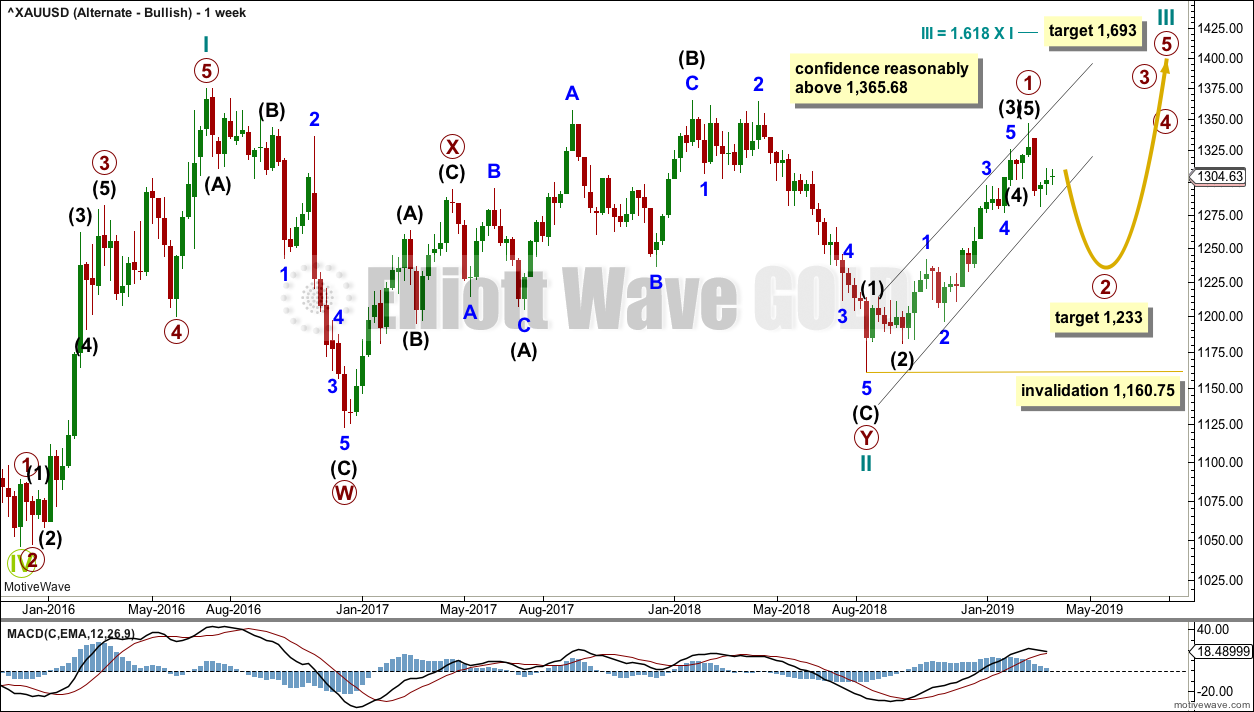
Alternate hourly chart updated:
Minuette (c) must subdivide as a five wave structure. Subminuette i is a leading contracting diagonal, submineutte ii is very deep. It’s typical of second waves following leading diagonals to be very deep. Now subminuette iii exhibits strength, this looks like a typical third wave.
Subminuette iv may not move into submineutte i price territory.
The target remains the same.
The larger picture still expects this is a corrective movement. I expect that the strength of this third wave may convince many it is not.
Agree, even little strong third waves try to convince me
…. ah, but I had those wave count invalidation points to calm me down. Good call on posting the alternate and thank you so much for doing so.
Wow, what just happened. I took a small risk bet buying gold at 1300. A few minutes later my £5 bet turned into £240. That was some strong move up.
Well done!
That’s my £240 you have – thanks 😁
Oh heck Jimmy were you betting on the sell side?
Yep – had it open for days … Won some back already – and will go short again when the time is right – so will win it back ..
Fed statement = quick move
Yes Dreamer , I didn’t realise at the time .